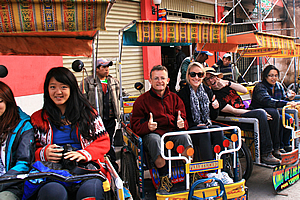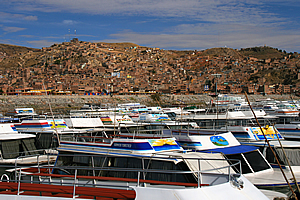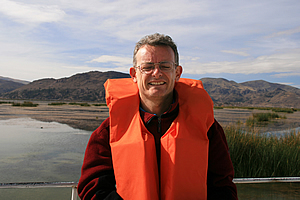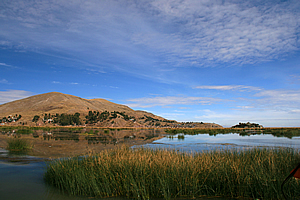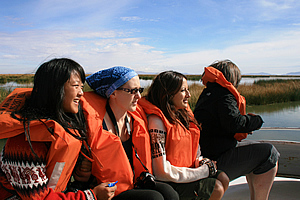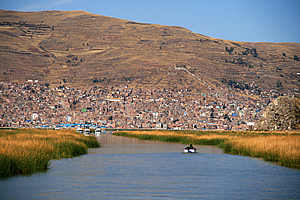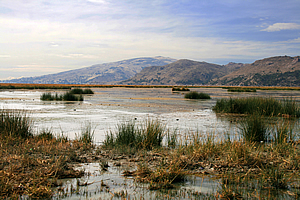--- Archive files ---
Home > Travels > Titicaca > 3 |
South American Cyclos
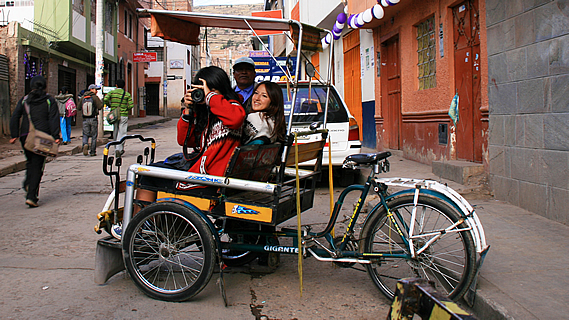
I STILL remember the fantastic experiences of being transported in a cyclo in Vietnam and Cambodia. Never did I expect I would see them here in Peru. Here they are called cargo bikes.
We had our usual bread and jam (though I didn’t have the jam still being put off by the Fanny brand), with aniseed tea, for breakfast before heading out to the front of the hotel with our daypacks. It was very cold outside, only just above freezing. This was normal for this time of year, heading into summer. Although we were in the tropics, the high altitude ensures a cold climate. During the middle of winter most mornings are around minus seven degrees.
On the cargo bikes |
There were six very brightly coloured cargo bikes sitting outside the hotel parked diagonally along the other side of the narrow lane awaiting us. These were bigger than the Asian cyclos though. The cyclos in Asia only had one passenger seat. Each cargo bike we were looking at had seating for two passengers. The front bumper bars had a clear inscription; “King of the Pedals” across it. How relevant.
A small blue rickshaw looking very much like a Thai tuk tuk passed the narrow lane between us and the cyclos before we crossed over to meet the riders.
The cyclos and tuk tuks made these narrow alleys feel somewhat like South East Asia. The freezing cold air convinced me I was still in Peru.
We took our seats in one of the cyclos, It was surprisingly comfortable sitting in the new seats underneath the flat canopy. A few of the guys were wearing alpaca wool clothing they had bought in Cusco to stay warm. They really looked the part.
A couple of group photos were taken before we set off quietly negotiating our way through the peak hour traffic along the narrow alleys. The gutters along the sides of the road were wet from the overnight thunderstorm. Occasionally there were potholes or blockages forming large puddles across the road. The riders just went straight through the puddles much to our delight.
Marina |
After five minutes travelling through the narrow alleyways of the inner city we reached a main road which we followed until the water of the lake was visible. We then stopped at a market to pick up any food we needed for the day. Once supplied, My tour leader Carlos led us to one of the jetties where a small launch was waiting for us in the midst of a substantial marina.
I was surprised such a remote lake at such high altitude serviced by such a sleepy city could possibly sustain so many boats in one marina. Most of these were small motor boats like the one we were boarding. I didn’t see any sail boats though. Perhaps the air is too thin to power them properly at this altitude. There were a couple of large commercial boats such as the SS Ollanta which is 79 metres long and weighs 2200 tonnes.
On the boat |
Ships have been sailing the lake since 1870. They were all constructed in the UK, dismantled into hundreds of transportable pieces, and brought all the way here to be assembled again. Even the small launches had to be transported here in pieces to be assembled. I assumed with the number of boats here there was quite a boat assembling industry here in Puno.
We climbed on board the boat to where Pablo, a slightly overweight brazen short man with black straight hair way too long began a rather long monotonous commentary as a lady started the boat. Once moving the boat chugged asthmatically away from the jetty through the crowded marina.
Reeds in the shallows of the lake |
Pablo mentioned that this was the highest navigable lake at 3809 metres above sea level. It was also one of the largest lakes in the world. Titicaca is the Hispanic spelling of the Quechuan word Titiqaqa. Unfortunately the meaning of the name has been lost in history.
The lake is fed by five main rivers draining the mostly arid landscape. 90 percent of the water that flows into the lake is evaporated thanks to the high altitude, the dry air and strong winds. What little water does flow out of the lake flows along the Rio Desaguadero into Lake Poopo in Bolivia. All the water that enters Lake Poopo is evaporated, so none of the water of this vast inland sea ever flows to the ocean.
Crossing the lake |
Even when obviously clear from the port the boat motored along at less than four knots – barely faster than a brisk walking pace. The hills that enclosed the bay were covered in dried grass merging into the rusty terracotta coloured buildings of the city behind us. All the buildings looked exactly the same from here. The expanse of black water was very short lived as we entered a long channel with reeds growing on either side. The channel was obviously artificial it ran dead straight. There were numerous clear pools in the reeds, but this was the only channel.
Back along the channel to Puno |
Finally Pablo finished his commentary and safety demonstration, and we were allowed onto the top deck. Most of us went up into the surprisingly strong sunlight and brilliant colours of the blue sky and the yellow reeds wearing super bright orange life jackets. If any of us were to fall overboard we would be very easy to find on the black water.
The boat seemed to be infinitely slow as we headed past a large headland with numerous buildings on it as an extension to the city. There were several small dinghies on the channel going to and from the city quite slowly. Wading birds explored the small rafts of dead floating reeds for food.
Reeds in the shallows of the lake |
We passed several ducks paddling through the water. Then we passed a man slowly rowing a dinghy obviously not in any hurry to go anywhere. The lethargic wake of our boat hardly rocked the dinghy.
Finally we passed a weather station on a solid small island in amongst the reeds. This was the first sign of civilisation since leaving Puno, but definitely not the last. In the distance ahead we could now see what appeared to be a village camouflaged well amongst the reeds.
<< Previous | Next >> |
|
||
About this Page
|
||
|
|
|
Where is Walkabout Jeff? |
|
|
|
|
What is happening in Walkabout Jeff's hometown?
|
|
|
|
|
Who is Walkabout Jeff?Any normal person's idea of going out involves going to the local pub for a drink with a few mates. Walkabout Jeff isn't normal.
|
|
|
|
|
